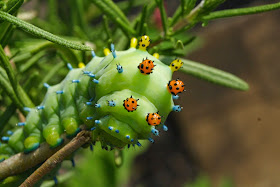 |
| Delphinium 'Blue Butterfly' - now at Jean S & my house |
Having just written the blog on Stevia (Stevia rebaudiana), the current fad in sugar substitute plants, I was interested in the herb they offered as Aztec Sweet Leaf (Lippia dulcis). This one is touted as having sweetness of 1500 times that of sugar. WHOA!
 |
| Sweet Aztec Leaf Plant (Tender perennial) |
I tasted a leaf. Yes. Sweet. Very sweet. Very, very sweet.
I bought a Salvia 'Honey Melon' sage plant whose leaves taste mildly of cantaloupe. The plant label shows a plant that looks like pineapple sage. This will most likely lose any flavor with cooking but should be an interesting addition to fruit salads and maybe as a drink garnish. I got the Sweet Leaf free.
In looking up the Sweet Leaf plant online I was surprised to see warnings about using it internally.
It turns out that in addition to hernandulcin, an intensely sweet compound which is a volatile oil constituent, the leaves also contain significant amount of camphor. According to the National Center for Biotechnology Information of the National Institutes of Health, listing a research article in the Journal of Ethnopharmacology (Lippia dulcis-Abstract), camphor is approximately 53% of the plant's oils.
The NCBI abstract notes: "This plant began to be used as an official drug in the late 19th century for the treatment of coughs and bronchitis, and at that time preliminary phytochemical investigations were undertaken. Field work carried out in Mexico in 1981 and 1982 has indicated that there is still an active trade involving L. dulcis, which is sold primarily in market places for its alleged abortifacient activity. We have obtained no evidence, either from the literature or from field inquiries, that L. dulcis has ever been used for sweetening foods or beverages."
Alas, while one or two leaves in a cup of tea may be okay, and a number of sites mentioning putting a few leaves in salads or fruit dishes, this plant is not going to replace Stevia any time soon.
The plant has a low growth habit, sending out runners, and would make an interesting hanging plant. The dark green leaves highlight very tiny, but pretty, white flowers. It's a tender perennial in zone 6 (no frost tolerance), is a fast growing, low creeper, with small white flowers and would be excellent in hanging baskets. Full sun, please.


















































